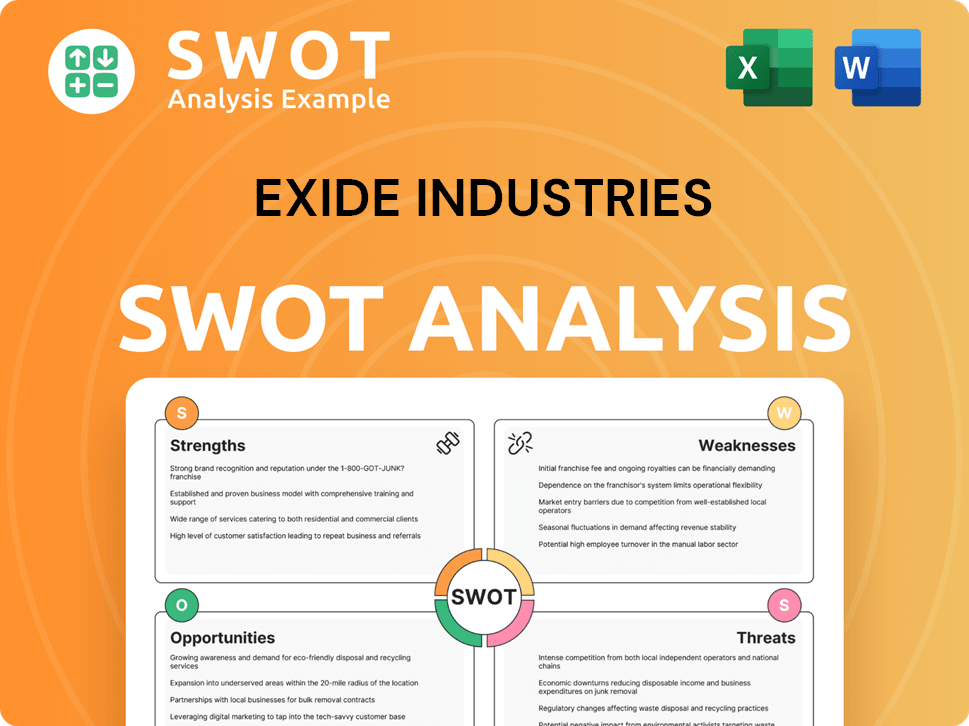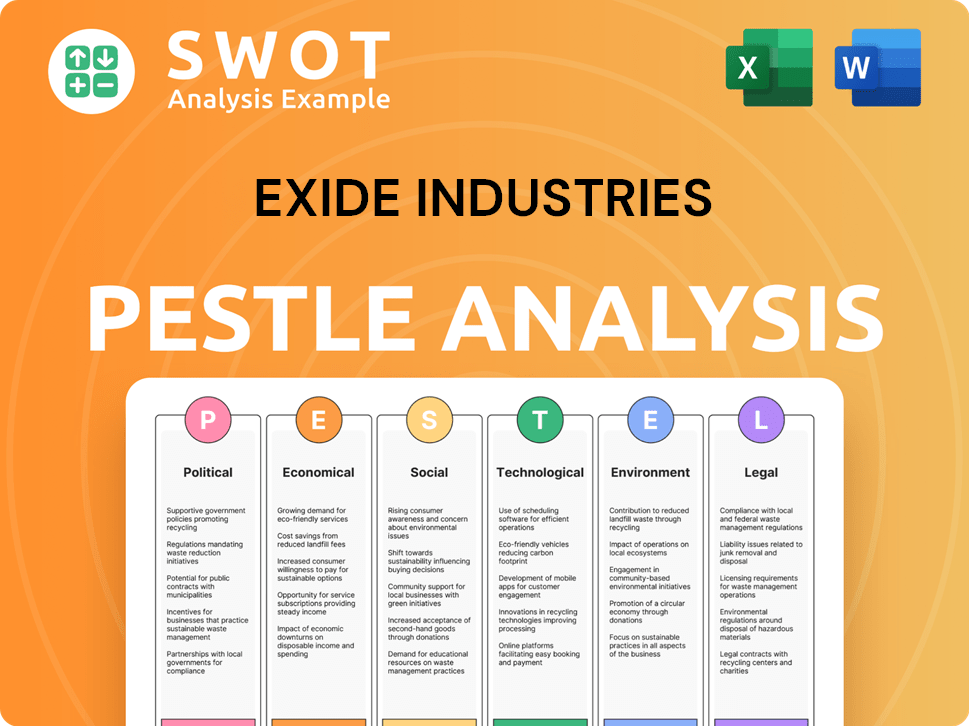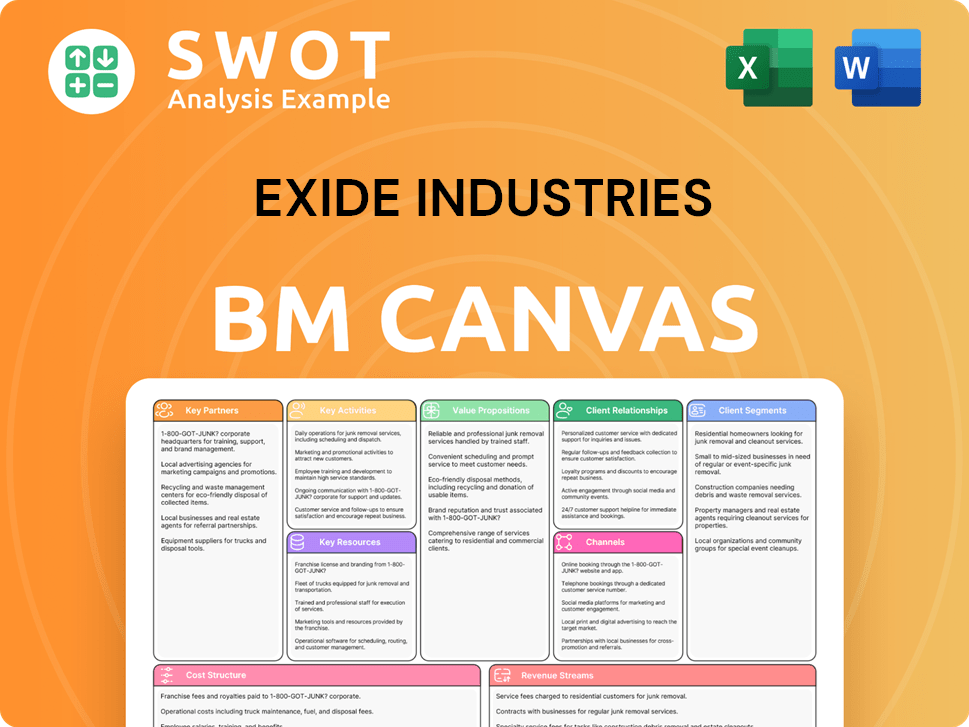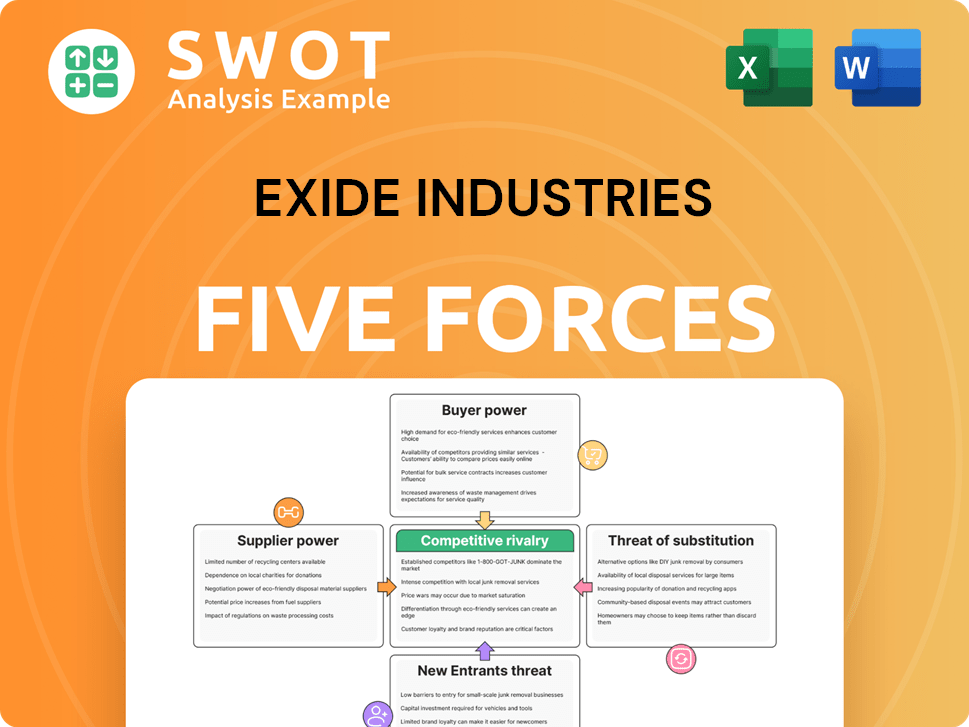Exide Industries Bundle
Can Exide Industries Power Up Your Portfolio?
Exide Industries, a titan in India's battery market, is charging ahead into a future dominated by electric vehicles and renewable energy. Founded in 1947, the company is strategically evolving, making significant investments in lithium-ion battery technology to stay at the forefront of the industry. This transformation highlights the critical role of its growth strategy and its impact on the company's future prospects.

This analysis delves into the Exide Industries SWOT Analysis, exploring its expansion plans, technological innovations, and financial performance. The company's ability to adapt to the changing market dynamics, especially in the Indian market, will be crucial for its future success. We will also examine the growth drivers for Exide Industries, its competitive landscape, and the impact of electric vehicles on its financial performance.
How Is Exide Industries Expanding Its Reach?
Exide Industries is strategically expanding its operations to capitalize on the evolving demands of the battery market. This expansion is primarily focused on the rapidly growing electric vehicle (EV) sector and the increasing need for stationary energy storage systems. The company is making significant investments and forming strategic partnerships to solidify its position in the Indian market and beyond.
The company's growth strategy involves a multi-pronged approach, including substantial investments in new manufacturing facilities, strategic collaborations with key players in the automotive industry, and geographical expansion into international markets. These initiatives are designed to boost the company's financial performance and secure its long-term future. For a detailed look at the ownership structure, you can refer to Owners & Shareholders of Exide Industries.
Exide Industries is actively pursuing several expansion initiatives to bolster its market position and diversify revenue streams. A cornerstone of this strategy is the significant investment in lithium-ion battery manufacturing.
Exide Energy Solutions Ltd (EESL) is establishing a large greenfield lithium-ion cell manufacturing facility in Bengaluru. The initial capacity is planned for 6 GWh by 2025, with intentions to expand to 12 GWh. This expansion is crucial for meeting the rising demand from the EV market and stationary energy storage systems.
Exide has already invested INR 33 billion in EESL for the new plant. The first phase is expected to be completed by the end of fiscal year 2025, with initial production starting in mid-2025 and commercial production ramping up towards the end of FY26.
A key collaboration is the non-binding Memorandum of Understanding (MoU) with Hyundai and Kia for strategic cooperation in developing and supplying battery cells for their electric vehicles in India. This partnership, formalized into a binding agreement in December 2024, will make Hyundai the first automaker in India to use domestically manufactured battery cells, enhancing localization and cost-efficiency.
Exide is also in advanced discussions with two leading two-wheeler companies and a major three-wheeler player to supply batteries. These partnerships are aimed at expanding the company's market reach within the Indian market.
Exide is increasing its focus on expanding exports and global presence, particularly in developed markets like America and Europe, aiming for a 15% increase in export sales year-on-year by 2024. The company plans to launch new products with advanced features for international markets and is also looking for new opportunities to export submarine batteries, engaging in active discussions with potential customers for FY 2024-25.
- The company aims to offer 'Cell to Pack' product portfolios for lithium-ion batteries.
- They plan to provide customizable module solutions and joint product development with customers.
- Exide is also targeting emerging applications like data centers, Battery Energy Storage Systems (BESS), traction (Material Handling Equipment electrification), and solar rooftops.
- The company is positioning itself in the clean energy space by rolling out comprehensive rooftop solar solutions, anticipating significant revenue streams given the Indian government's target of 40 GW from rooftop solar by 2026.
Exide Industries SWOT Analysis
- Complete SWOT Breakdown
- Fully Customizable
- Editable in Excel & Word
- Professional Formatting
- Investor-Ready Format

How Does Exide Industries Invest in Innovation?
The innovation and technology strategy of Exide Industries is crucial for its competitors landscape of Exide Industries and future growth in the dynamic battery market. The company is heavily investing in research and development to maintain its competitive edge, especially with the rapid evolution of battery technology. This strategic focus is essential for navigating the challenges and opportunities within the Indian market and beyond.
A significant aspect of Exide Industries' strategy involves substantial R&D investments, with an annual budget of approximately ₹500 crores. This financial commitment underscores the company's dedication to innovation and improvement in battery efficiency. The primary goal is to develop advanced battery technologies that enhance performance, increase efficiency, and reduce costs, which are key drivers for its growth strategy.
Exide is actively developing its lithium-ion cell manufacturing capabilities through its subsidiary, Exide Energy Solutions Ltd (EESL). This subsidiary is establishing a gigafactory in Bengaluru to produce lithium-ion cells using Nickel Manganese Cobalt (NMC) and Lithium Iron Phosphate (LFP) chemistries. These cells will serve both mobility and stationary applications, demonstrating Exide's commitment to expanding its product offerings.
Exide allocates around ₹500 crores annually for R&D, focusing on battery efficiency and advanced technologies.
EESL is building a gigafactory in Bengaluru to produce lithium-ion cells with NMC and LFP chemistries for mobility and stationary applications.
Exide has a multi-year agreement with SVOLT Energy Technology for lithium-ion cell manufacturing technology and know-how.
The company is implementing digitization across various processes to streamline operations and improve decision-making.
Exide aims to reduce its carbon footprint by 25% by 2025 and has already achieved a 15% reduction between 2022 and 2023.
Exide has operational photovoltaic systems with a combined capacity of 12.8 MWp as of FY24 and aims for 30% revenue from renewable energy by 2025.
Exide is also embracing digital transformation and automation to streamline operations and improve decision-making. Sustainability is deeply integrated into its technology strategy, with a focus on reducing its carbon footprint and expanding renewable energy sources. The company's commitment to these initiatives is designed to drive long-term growth and enhance its financial performance.
- Digitalization across processes such as integrated business planning and logistics.
- Emphasis on manufacturing excellence through LEAN and waste minimization practices.
- Target to reduce carbon footprint by 25% by 2025, with a 15% reduction achieved between 2022 and 2023.
- Recycling of over 98% of lead from used batteries.
- Expansion of photovoltaic systems, with 5 installations operational as of FY24, generating 12.8 MWp.
- Aim to generate 30% of revenue from renewable energy solutions by 2025.
Exide Industries PESTLE Analysis
- Covers All 6 PESTLE Categories
- No Research Needed – Save Hours of Work
- Built by Experts, Trusted by Consultants
- Instant Download, Ready to Use
- 100% Editable, Fully Customizable

What Is Exide Industries’s Growth Forecast?
Exide Industries anticipates significant financial growth, driven by strategic investments and evolving market demands within the Indian Market. The company is targeting a revenue of ₹20,000 crore over the next two to three years, primarily supported by its performance in the lead-acid battery segment. This growth strategy also considers the evolving Battery Market landscape.
For the fiscal year 2024-25, Exide posted revenues of ₹16,588 crore. Recent financial reports show a mixed but optimistic outlook. The company's Profit After Tax (PAT) for FY 2025 increased by 3% to ₹1,077 crore compared to FY 2024. The profit margin for FY 2025 was 4.6%, down from 5.2% in FY 2024, due to higher expenses. These figures highlight the company's Financial Performance.
The company's expansion plans include significant capital expenditure, with ₹3,500-₹4,000 crore earmarked for FY2025-FY2026, mainly for its lithium-ion cell manufacturing plant in Bengaluru. The first phase of this gigafactory involves a total investment of ₹5,000 crore. As of March 31, 2024, Exide held unencumbered cash and liquid investments of ₹581.9 crore and a healthy debt-to-equity ratio of 0.5, demonstrating a strong financial position. The company's investment of approximately ₹5,500 crore in HDFC Life Insurance Company Limited further enhances its financial flexibility.
Exide Industries aims for ₹20,000 crore in revenue within two to three years. The lead-acid battery segment is a key driver, with contributions from the lithium-ion segment expected to grow. The company's focus on the mobility aftermarket and solar businesses has also supported revenue growth.
For FY 2025, Profit After Tax (PAT) rose by 3% to ₹1,077 crore. Revenue increased by 2.8% to ₹172.4 billion. The profit margin was 4.6%, reflecting higher expenses. The company's strategic investments are expected to drive future growth.
Exide plans to spend ₹3,500-₹4,000 crore in FY2025-FY2026, primarily on a lithium-ion cell manufacturing plant. The total investment for the first phase of this gigafactory is estimated at ₹5,000 crore. The company maintains a strong liquidity position, with substantial cash reserves and investments.
Part of the capital expenditure will be debt-funded, but the company's consolidated capital structure is projected to remain strong. As of March 31, 2024, Exide had a healthy debt-to-equity ratio of 0.5. The investment in HDFC Life Insurance provides additional financial flexibility.
Analyst share price targets vary, with some projecting ₹1,086 by 2025. Citi analysts revised their target price to ₹560 per share, implying a potential upside. These forecasts reflect the company's continued R&D investment and strategic partnerships.
The company's growth strategy includes investments in lithium-ion technology and expansion in the mobility aftermarket. Exide is adapting to the evolving Battery Market and the increasing adoption of electric vehicles. For more insights, see the Marketing Strategy of Exide Industries.
Exide Industries Business Model Canvas
- Complete 9-Block Business Model Canvas
- Effortlessly Communicate Your Business Strategy
- Investor-Ready BMC Format
- 100% Editable and Customizable
- Clear and Structured Layout

What Risks Could Slow Exide Industries’s Growth?
The growth trajectory of Exide Industries, while promising, is intertwined with several potential risks and obstacles. These challenges span from intense competition within the battery market to the rapid evolution of technology and regulatory changes. Understanding these potential pitfalls is crucial for assessing the company's long-term viability and strategic positioning.
One key factor to consider is the dynamic nature of the Indian Market and the global battery industry. The emergence of new competitors and the evolution of existing players could pose significant challenges. Furthermore, the company's financial performance may be influenced by external factors such as raw material prices and the pace of electric vehicle adoption.
Exide Industries' Growth Strategy and Future Prospects are subject to several potential risks that could impact its ambitions. The company needs to navigate these challenges effectively to maintain its market position and capitalize on emerging opportunities.
The Battery Market is highly competitive, with numerous players vying for market share. New entrants and aggressive strategies from existing competitors could pressure Exide Industries' market position. This competitive landscape necessitates continuous innovation and strategic adaptation.
Rapid advancements in battery technology, especially in the electric vehicle (EV) sector, pose a significant risk. Failure to keep pace with technological improvements, such as the shift towards advanced lithium-ion chemistries, could jeopardize Exide's market position. Continuous investment in research and development is crucial.
Supply chain disruptions, including shortages of raw materials and increased manufacturing costs, can impact profitability. For example, a sharp rise in antimony prices has negatively affected margins. The company has implemented price adjustments to offset these costs.
Tightening environmental regulations regarding waste, recycling, and pollution could increase operating costs. The battery industry has inherent regulatory risks due to the hazardous nature of lead recycling operations. Exide is enhancing its reliance on renewable sources to minimize the impact.
Constraints in skilled labor and infrastructure for new technologies like lithium-ion cell manufacturing could pose an obstacle. Furthermore, slower-than-expected adoption of electric vehicles or lower-than-anticipated volumes in key automotive segments could impact revenue growth.
With approximately 69% of its revenue derived from the automotive sector, Exide is significantly exposed to fluctuations in this market. A slowdown in automotive OEM volumes could negatively affect near-term revenue growth. The company is expected to benefit from the first battery-replacement cycle, with increased demand anticipated in fiscal 2025.
To mitigate these risks, Exide Industries is diversifying its revenue base and strategically investing in new technologies. The company is actively involved in lithium-ion cell manufacturing to capitalize on the growth of the EV market. Strategic investments in digitalizing all business processes ensure real-time data availability, supporting accurate decision-making and the early identification of business risks.
The pace of electric vehicle adoption is a critical factor influencing Exide Industries' future prospects. While the company is preparing for the transition, the speed at which EVs penetrate the market will significantly affect its revenue streams. For a deeper understanding of the company's strategies, you can explore an article on Exide Industries' market share analysis.
Exide Industries Porter's Five Forces Analysis
- Covers All 5 Competitive Forces in Detail
- Structured for Consultants, Students, and Founders
- 100% Editable in Microsoft Word & Excel
- Instant Digital Download – Use Immediately
- Compatible with Mac & PC – Fully Unlocked

Related Blogs
- What are Mission Vision & Core Values of Exide Industries Company?
- What is Competitive Landscape of Exide Industries Company?
- How Does Exide Industries Company Work?
- What is Sales and Marketing Strategy of Exide Industries Company?
- What is Brief History of Exide Industries Company?
- Who Owns Exide Industries Company?
- What is Customer Demographics and Target Market of Exide Industries Company?
Disclaimer
All information, articles, and product details provided on this website are for general informational and educational purposes only. We do not claim any ownership over, nor do we intend to infringe upon, any trademarks, copyrights, logos, brand names, or other intellectual property mentioned or depicted on this site. Such intellectual property remains the property of its respective owners, and any references here are made solely for identification or informational purposes, without implying any affiliation, endorsement, or partnership.
We make no representations or warranties, express or implied, regarding the accuracy, completeness, or suitability of any content or products presented. Nothing on this website should be construed as legal, tax, investment, financial, medical, or other professional advice. In addition, no part of this site—including articles or product references—constitutes a solicitation, recommendation, endorsement, advertisement, or offer to buy or sell any securities, franchises, or other financial instruments, particularly in jurisdictions where such activity would be unlawful.
All content is of a general nature and may not address the specific circumstances of any individual or entity. It is not a substitute for professional advice or services. Any actions you take based on the information provided here are strictly at your own risk. You accept full responsibility for any decisions or outcomes arising from your use of this website and agree to release us from any liability in connection with your use of, or reliance upon, the content or products found herein.